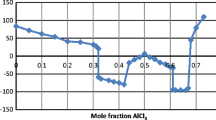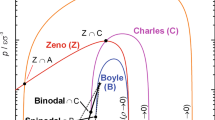Abstract
Permittivity data from 0.9 to 40 GHz for acetonitrile and 0.05 to 1.4 molar acetonitrile solutions of Bu4NBr at 25°C are used to exemplify the behavior of ion pairs in high frequency electric fields. Measurements were excuted by the method of travelling waves with equipment known to produce data of high precision. Data analysis of the acetonitrile spectrum shows a single relaxation process at relaxation time of 3.5 ps for the solvent reorientation; the spectra of the salt solutions reveal two relaxation processes with relaxation times increasing from 3.5 to 6.8 ps for the solvent and decreasing from 120 to 70 ps for the ion pair [Bu4NBr]o at increasing salt concentration. The association constant of Bu4NBr in acetonitrile determined by permittivity measurements agrees well with that from conductance measurements. The concentration-dependence of the ion-pair relaxation times reveals the rate constants of ion-pair formation and decomposition.
Similar content being viewed by others
References
C. J. F. Böttcher and P. Bordewijk,Theory of Electric Polarization, Vol. II, (Elsevier, Amsterdam, 1978).
J. Barthel, H. J. Gores, G. Schmeer, and R. Wachter, “Non-Aqueous Solutions in Chemistry and Modern Technology”, F. Boschke ed.,Topics in Current Chemistry 111, (Springer, Heidelberg, 1983) p. 33.
J. Barthel and H.-J. Wittmann, unpublished results
J. Barthel,Ionen in Nichtwäßrigen Lösungen (Dietrich Steinkopff Verlag, Darmstadt, 1976).
R. Pottel and O. Lossen,Ber. Bunsenges. Phys. Chem. 71, 135–146 (1967).
H. Behret, F. Schmithals, and J. Barthel,Z. Phys. Chem. 96, 73 (1975).
J. Barthel, J. Krüger, and E. Schollmeyer,Z. Phys. Chem. 104, 59 (1977).
J. Barthel and F. Feuerlein,J. Solution Chem. 13, 393 (1984).
P. Winsor and R. H. Cole,J. Phys. Chem. 86, 2486 (1982).
J. Barthel, R. Buchner and H. J. Wittmann,Z. Phys. Chem. NF 139, 23 (1984).
U. Kaatze,Z. Phys. Chem. NF 135, 51 (1983).
R. Pottel,Ber. Bunsenges. Phys. Chem. 69, 363 (1965).
U. Kaatze, V. Lönnecke and R. Pottel,J. Phys. Chem. 91, 2206 (1987).
M. Delsignore, H. E. Maaser and S. Petrucci,J. Phys. Chem. 88, 2405 (1984).
M. Delsignore, H. Farber, and S. Petrucci,J. Phys. Chem. 89, 4968 (1985).
H. Cachet, M. Fekir, and J.-C. Lestrade,Can. J. Chem. 59, 1051 (1981).
H. Farber, D. E. Irish, and S. Petrucci,J. Phys. Chem. 87, 3515 (1983).
H. E. Maaser, M. Delsignore, M. Newstein, and S. Petrucci,J. Phys. Chem. 88, 5100 (1984).
H. Farber and S. Petrucci,J. Phys. Chem. 85, 2987 (1981).
H. Delsignore, H. Farber and S. Petrucci,J. Phys. Chem. 90, 66 (1986).
J. Barthel and R. Buchner,Pure Appl. Chem. 58, 1077 (1986).
T. J. Buchanan,Proc. Inst. Elec. Eng. Part III 99, 61 (1952).
J. Barthel,Pure Appl. Chem. 51, 2093 (1979).
J. Barthel, R. Buchner and H. Steger,Wiss. Z. Tech. Hochsch. Chem. Leuna-Merseburg 31, 409 (1989).
J. Barthel, R. Wachter und H. J. Gores, inModern Aspects of Electrochemistry, Vol. 13, B. E. Conway and J. O'M. Bockris, eds., (Plenum, New York, 1979) Chap. 1.
J. E. O'Donnel, J. T. Ayres and C. K. Mann,Anal. Chem. 37, 1161 (1965).
J. Barthel and H. Utz, unpubished data
T. T. Bopp,J. Chem. Phys. 47, 3621 (1967).
K. E. Arnold and J. Yarwood,Mol. Phys. 48, 451 (1983).
S. H. Glarum,J. Chem. Phys. 33, 1371 (1960).
S. H. Glarum,J. Chem. Phys. 33, 639 (1960).
E. S. Rittner,J. Chem. Phys. 19, 1030 (1951).
W. R. Gilkerson and J. L. Steward,J. Phys. Chem. 65, 1465 (1961).
D. Menard and M. Chabanel,J. Phys. Chem. 79, 1081 (1975).
E. A. S. Cavell, P. C. Knight and M. A. Sheikh,J. Chem. Soc. Faraday Trans. 67, 2225 (1971).
T. G. Scholte,Physica 15, 437 (1949).
C. Treiner and R. Fuoss,Z. Phys. Chem. Leibzig 228, 343 (1965).
G. A. Forcier and J. W. Olver,Electrochim. Acta 14, 135 (1969).
A. C. Harkness and H. M. Daggett,Can. J. Chem. 43, 1215 (1965).
D. F. Evans, C. Zawoyski and R. L. Kay,J. Phys. Chem. 69, 3878 (1965).
C. G. Seefried, Thesis, Yale (1969).
G. Kabisch,Ber. Bunsenges. Phys. Chem. 80, 602 (1976).
G. Kabisch,Schwingungsspektroskopische und Kernresonanzuntersuchungen an Tetraalkylammoniumsalzlösungen (Akademie-Verlag, Berlin, 1979).
J. E. Anderson,J. Chem. Phys. 51, 3578 (1969).
J. E. Anderson,Ber. Bunsenges. Phys. Chem. 75, 294 (1971).
H. Strehlow and W. Knoche,Fundamentals of Chemical Relaxations (Verlag Chemie, Weinheim, 1977).
J.-C. Lestrade, J.-P. Badiali and H. Cachet inDielectric and Related Molecular Processes, Vol. II, (The Chemical Society, London, 1975).
J. Barthel, R. Buchner, B. Gill, K. Bachhuber, and M. Kleebauer,Chem. Phys. Lett. in preparation.
F. Accascina, S. Petrucci and R. M. Fuoss,J. Am. Chem. Soc. 81, 1301 (1959).
J. B. Hubbard and L. Onsager,J. Chem. Phys. 67, 4850 (1977).
J. B. Hubbard,J. Chem. Phys. 68, 1649 (1978).
J. B. Hubbard, P. Colonomos, and P. J. Wolynes,J. Chem. Phys. 71, 2652 (1979).
Author information
Authors and Affiliations
Rights and permissions
About this article
Cite this article
Barthel, J., Kleebauer, M. The behavior of ion pairs in high frequency electric fields exemplified by acetonitrile solutions of Bu4NBr. J Solution Chem 20, 977–993 (1991). https://doi.org/10.1007/BF00663997
Received:
Issue Date:
DOI: https://doi.org/10.1007/BF00663997




